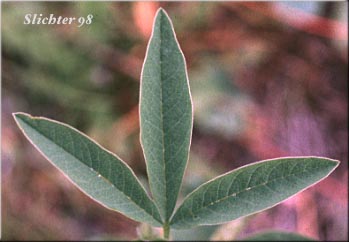 The photo at right shows a close-up frontal view of the flower of golden pea (variety ovatum) as seen along Balloon Tree Road, Umatilla National Forest ........June 27, 2006.
The photo at right shows a close-up frontal view of the flower of golden pea (variety ovatum) as seen along Balloon Tree Road, Umatilla National Forest ........June 27, 2006.
Golden pea is an attractive perennial wildflower with several erect stems from 40-100 cm in height. The leaves are alternately arranged along the stems and are pinnately compound with the leaflets linear-elliptic to broadly ovate-elliptic in shape, and 5-10 cm long. The plant varies in hairiness overall, from nearly glabrous to densely pubescent. The upper surface of the leaflets typically is glabrous while the underside is copiously covered with appressed hairs. The stipules are also variable in length, ranging from very small to nearly the length of the leaflets.
The flowers are yellow, 20 to 25 mm long, borne in small to long racemes as much as 30 cm long. Five to fifty flowers may make up the inflorescence. The pedicels are slightly shorter than to equal in length with the calyx. The calyx is thinly to densely haired and measures 9-10 mm long with teeth that are slightly shorter than the calyx tube. The pods are erect to somewhat spreading, straight, somewhat hairy and two to five seeded. They measure 7-8 cm long and about 7 mm wide.
Golden pea is found on sandy, well-drained soil to wet meadows.
Golden pea is found from British Columbia south to California, and from the Pacific coast eastward to the Rocky Mountains of Montana and Colorado.
In the Columbia River Gorge, it may be found between the elevations of 400'-4300' from Silver Star Mt. in the west eastward to the upper drainage of the Washougal River.
